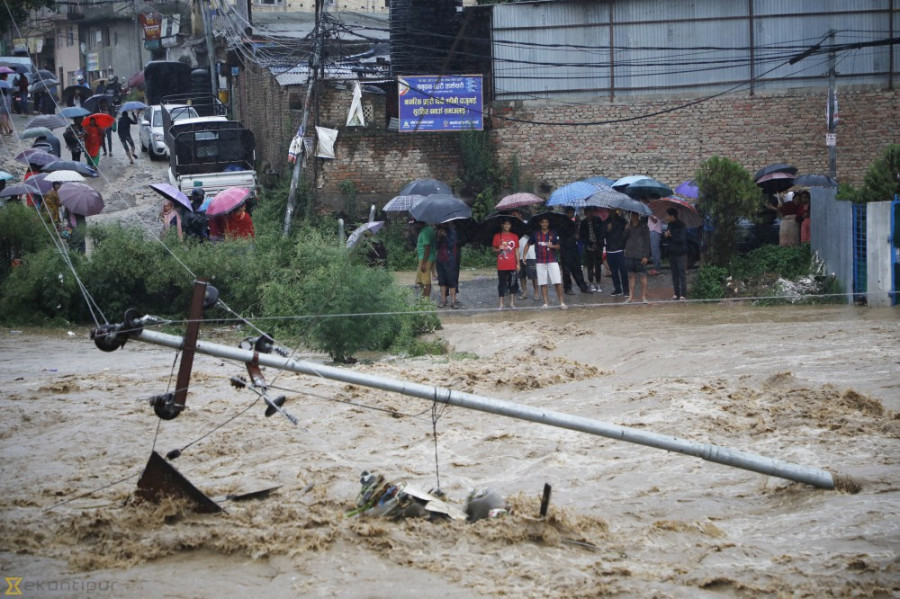Columns
Are we prepared for the monsoon disaster?
Local governments—being the first responders—do not have the training, financial support and technical know-how to manage such crises.
Raju Chauhan
While the arrival of monsoon was a respite from the scorching heat, especially for the farmers whose agricultural yield depends on the rain, the incessant rainfall also caused floods and landslides in many parts of the country. As this is a perennial problem, making the optimum use of the rain for agriculture, water recharge and harvesting while preventing monsoon-induced disasters has to be the government’s priority.
According to a National Planning Commission report, the floods in August 2017 alone caused damages worth $584 million. The monsoon looks fiercer if we observe the death toll. According to the disaster database of the Ministry of Home Affairs, floods, landslides, heavy rainfall and thunderstorms during the monsoon season of 2016 claimed 293 lives. This toll was 269 in 2017 and 132 in 2018. The disaster data shows that such occurrences alone account for 15 percent of the annual death toll and 10 percent of the annual economic damage.
Since disasters during the rainy season is a common feature, the government’s priority should lie in disaster-risk management and prevention. The government should thus remain proactive and identify vulnerable settlements and infrastructures that are likely to be impacted by the flood and landslides. It should also have a solid idea of whether the established early warning systems are installed in proper places and are functioning effectively. Further, the government needs to reflect on many other aspects related to disaster risk management. It needs to hold enough mock drills to get familiar with the potential facets of the crisis. The concerned agencies at various levels of government need to be well equipped and trained to respond during emergencies. Further, the government needs to ask itself: Are we capable of taking timely action if a colossal disaster hits the country again? Are we committed to managing risk to achieve zero loss of life and property in future monsoon seasons? The answer to these questions will reflect the government's effort and seriousness toward disaster risk management.
Learning lessons from the devastation and losses that have incurred in the past will be key for disaster risk management as it will help identify the loopholes and strengthen the weakness, particularly in the managerial front. Yet, the investigation and inquiry for identification of the lapses in disaster management are lacking. Whether it be the Gorkha earthquake or the Tarai flood of 2017, no independent research other than one conducted by the government authority were conducted. Because of this, the effectiveness of current practices and culpability of the government agencies accountable for disaster management is never disclosed. Independent investigations and recommendations made by them could be a home-made remedy to strengthen and empower the existing disaster management system to minimise risk and prepare for anticipated disaster.
In the last three years, initiatives in mainstreaming the legal frameworks and disaster management policies to be in line with the country’s new federal structure have been commendable. But preparing for disaster doesn’t mean confining the plans and policies only in paper. The commitment should translate into action too. It also means that the agencies and organisations entrusted with disaster management are in full shape and functioning smoothly. Unfortunately, when it comes to policy implementation there is much to be desired. The government is yet to appoint the head of the National Disaster Risk Reduction and Management Authority (NDRRMA) which is mandated to lead, support and coordinate with all agencies on disaster risk management.
The most effective way of preparing for the havoc during monsoon and beyond is decentralisation of the disaster management efforts. Livelihood improvement also means reducing the underlying risk. Thus opportunities exist to address disaster risk reduction and development simultaneously, especially in the current system where there are three tiers of government. Integration of disaster risk concerns into development policy, plans and initiatives at the local level would both strengthen community resilience and contribute to sustainable development.
Being prepared for the disaster requires not only planned and coordinated efforts but also timely action. First, decentralisation of the authorities for disaster risk management as provisioned by the existing legal frameworks and full-fledged operation of these institutions at the provincial and local level should be done as soon as possible. Second, these institutions should be capacitated and equipped adequately to manage and reduce disaster risk as part of preparedness and to act effectively for rescue and relief during a disaster. Third, risk assessment and mitigation need to be given higher priority while pre-disaster preparations and enhancement of post-disaster coping should go together. Fourth, encouraging community leadership for risk mitigation and effective disaster response is vital, including in the initiatives such as early warning system establishment, operations and management.
Local governments and communities are the first responders during a disaster. Yet, they do not have the training, adequate financial support and technical know-how in managing disaster and dealing with the crisis. Statistics show that local governments have allocated only about 5 percent of all local budgets for disaster risk and management activities. With proper mainstreaming of risk reduction in local level planning and implementation, allocating adequate resources, capacity building of local authorities entrusted for disaster risk mitigation and preparedness, and supporting communities to strengthen their own resilience will help to mitigate risk and at the same time prepare effectively for the anticipated disaster.
Chauhan is the programme coordinator for Youth Alliance for Environment.
***
What do you think?
Dear reader, we’d like to hear from you. We regularly publish letters to the editor on contemporary issues or direct responses to something the Post has recently published. Please send your letters to [email protected] with "Letter to the Editor" in the subject line. Please include your name, location, and a contact address so one of our editors can reach out to you.




 6.1°C Kathmandu
6.1°C Kathmandu















